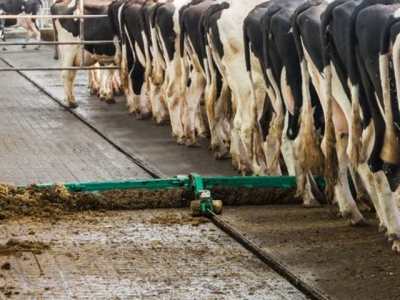Managing barn scrapers contributes to dairy safety, hygiene

Managing manure for cow hygiene now as automated as ever.
Dirty cows have a negative impact on milk quality, including greater chances of getting mastitis and a high somatic cell count. Dirty cows usually mean a dirty tail, and dirty tails can come from dirty stalls. Since the ban on tail docking of dairy cattle, managing manure for cow hygiene is as automated as it has ever been.
“Automated alley scraper systems have been successfully used on livestock farms for decades to keep freestalls and cows clean,” said Andy Lenkaitis, GEA product manager for manure equipment. “I work with many farmers who produce high-quality milk and have cows with long tails. They make management of their automated alley scraper systems a priority to avoid tail entanglement or animal injury.”
Lenkaitis suggested the following tips to manage an alley scraper system to help ensure cow safety and cleanliness.
For the scraper system:
* Check the control panel load sensor seasonally to monitor the scraper system’s power. Monitoring its power will limit the chance of creating extremely high cable tension and help avoid abnormal power spikes.
* Manage the control panel settings for proper sensitivity, especially during dry conditions or when stalls are bedded.
* Properly adjust the tension of the scraper cable, rope or chain system to prevent scrapers from jumping around and potentially pinching a tail against the curb.
* Leave 1 in. between the scraper wing and the curb to help prevent pinching tails.
* Consider having a scraper wing with a roller for offset alleys or if to keep the blade tip from touching the curb.
* Choose a blade that has smooth surfaces near the stall beds as they make it more difficult to snag tail hair.
* Take care of sharp edges, protruding bolts or pinch points immediately to reduce injury to cows.
For freestall barns:
* Be sure the brisket board is in its proper position for the herd (typically 65-72 in. ahead of the rear curb) to allow cows to move ahead in the stall. This adjustment will allow cows to have more of their body in the stall. Note: It may require more frequent cleaning of the stall bed because the chance of manure in the rear third of the stall may increase.
* Maintain a fly abatement program and ensure proper airflow to reduce the presence of flies. This reduces the likelihood that a cow will swing her tail and leave it in the alley.
* Adjust scraper run times to align with milking, feeding or pushing up feed to reduce the chance of a cow lying in the stall at scraping times.
* Alter feeding patterns to align with the scraper position in pens.
Other management considerations include having safety glasses for employees to prevent tail switches from harming their eyes during milking. Having a tail trimming protocol that works for a dairy’s schedule is also beneficial.
“A clean environment is key for high-milk quality,” Lenkaitis said. “By taking care of your automated barn scraper system, you will take care of your cows, and your cows will take care of you.”
Có thể bạn quan tâm
 Cattle, poultry in-feed drug suspected in horse deaths
Cattle, poultry in-feed drug suspected in horse deaths The FDA is investigating a series of horse deaths reportedly linked to the presence of a cattle and poultry drug in contaminated feed.
 Lallemand offers tips to avoid fall slump in dairy cow production
Lallemand offers tips to avoid fall slump in dairy cow production Change from old corn silage to freshly cut forage can create problems
 Injectable trace minerals may improve mineral status of beef heifers
Injectable trace minerals may improve mineral status of beef heifers Strategy may have variable effects on reproductive performance.